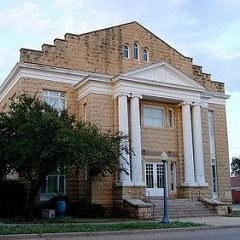About Us
In 1907, Reverend George Fender, Pastor of the Ballinger Presbyterian Church first wrote to Andrew Carnegie for a grant. In February of 1908, $12,500 was offered by Carnegie. A local businessman, Jo Wilmeth, donated the land for the library to be built on. Construction began November 20, 1908. The Cornerstone was laid in February of 1909. By 1910, a Scottish local, Jack McGregor, wrote to Andrew for another $5,000, which was rewarded. On May 6, 1911, the Carnegie Library officially opened it's doors with a ticketed musical recital held in the upstairs auditorium. The library has since been a big part of the community. During the depression, the kitchen was used to cook meals to feed local school children. The library then fell into operational hardship once again after World War II. After various repairs, the building then became the Army and Navy Club with the auditorium being turned into a ballroom. It was also used for various groups such as the Boy and Girl Scouts and the garden club. The library went under a huge restoration in the 1970s, led by Mary Sykes that was completed in 1986. The Carnegie Library has it's many different uses and functions that serve the community. It is a historical landmark that has withstood the test of time. Tours of the library are given out to visitors along with more detailed history, and you can sign our guestbook to let us know you were here.
https://carnegie-ballinger.ploud.net/about-us
https://carnegie-ballinger.ploud.net/++resource++plone-logo.svg
About Us
In 1907, Reverend George Fender, Pastor of the Ballinger Presbyterian Church first wrote to Andrew Carnegie for a grant. In February of 1908, $12,500 was offered by Carnegie. A local businessman, Jo Wilmeth, donated the land for the library to be built on. Construction began November 20, 1908. The Cornerstone was laid in February of 1909. By 1910, a Scottish local, Jack McGregor, wrote to Andrew for another $5,000, which was rewarded. On May 6, 1911, the Carnegie Library officially opened it's doors with a ticketed musical recital held in the upstairs auditorium. The library has since been a big part of the community. During the depression, the kitchen was used to cook meals to feed local school children. The library then fell into operational hardship once again after World War II. After various repairs, the building then became the Army and Navy Club with the auditorium being turned into a ballroom. It was also used for various groups such as the Boy and Girl Scouts and the garden club. The library went under a huge restoration in the 1970s, led by Mary Sykes that was completed in 1986. The Carnegie Library has it's many different uses and functions that serve the community. It is a historical landmark that has withstood the test of time. Tours of the library are given out to visitors along with more detailed history, and you can sign our guestbook to let us know you were here.
There are currently no items in this folder.
